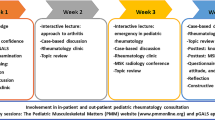Abstract
Given the burden of rheumatic disease in our society and the anticipated future shortage of rheumatologists, all internal medicine (IM) residencies need to train internists who are capable of caring for patients with rheumatic diseases. The objective of this study was to perform a targeted needs assessment of the self-confidence of IM residents in the evaluation and care of patients with rheumatologic diseases. A 16-item, web-based, self-assessed confidence survey tool was administered to participating post graduate year (PGY)1 (N = 83) and PGY3 (N = 37) residents. The categories of questions included self-confidence in performing a rheumatologic history and exam, performing common rheumatologic procedures, ordering and interpreting rheumatologic laboratory tests, and caring for patients with common rheumatologic diseases. Resident demographics, prior rheumatology exposure, and career plans were also queried. PGY3 residents had higher self-assessed confidence than PGY1 residents in all categories. Self-assessed confidence in joint procedures was consistently low in both groups and when compared to other categories. Prior exposure to a rheumatology course or elective was not consistently associated with higher self-assessed confidence ratings across all categories. PGY3 residents showed less interest in rheumatology as a career than PGY1 residents, although the interest in the topic of rheumatology was not statistically different. Our needs assessment shows a low level of self-assessed confidence in rheumatology knowledge and skills among IM residents. Despite improvement with PGY year of training, self-assessed confidence remains low. To improve resident’s skills and self-confidence in rheumatology, more curricular innovations are needed. Such innovations should be assessed for overall effectiveness.


Similar content being viewed by others
References
Centers for Disease Control and Prevention (CDC) (2013) Prevalence of doctor-diagnosed arthritis and arthritis-attributable activity limitation—United States, 2010-2012. MMWR Morb Mortal Wkly Rep 62:869–873
Schappert SM, Rechtsteiner EA (2011) Ambulatory medical care utilization estimates for 2007. National Center for Health Statistics. Vital Health Stat 169:1–38
Deal CL, Hooker R, Harrington T, Birnbaum N, Hogan P, Bouchery E et al (2007) The United States rheumatology workforce: supply and demand, 2005-2025. Arthritis Rheum 56:722–729
Freedman KB, Bernstein J (1998) The adequacy of medical school education in musculoskeletal medicine. J Bone Joint Surg Am 80:1421–1427
James NJ, Hussain R, Moonie A, Richardson D, Waring WS (2012) Patterns of admissions in an acute medical unit: priorities for service development and education. Acute Med 11:74–80
Houston TK, Connors RL, Cutler N, Nidiry MA (2004) A primary care musculoskeletal clinic for residents: success and sustainability. J Gen Intern Med 19:524–529
Wilcox T, Oyler J, Harada C, Utset T (2006) Musculoskeletal exam and joint injection training for internal medicine residents. J Gen Intern Med 21:521–523
Meyers FJ, Weinberger SE, Fitzgibbons JP, Glassroth J, Duffy FD, Clayton CP et al (2007) Redesigning residency training in internal medicine: the consensus report of the Alliance for Academic Internal Medicine Education Redesign Task Force. Acad Med 82:1211–1219
Katz SJ, Oswald AE (2011) How confident are internal medicine residents in rheumatology versus other common internal medicine clinical skills: an issue of training time or exposure? Clin Rheumatol 30:1081–1093
Smith CC, Newman L, Davis RB, Yang J, Ramanan R (2005) A comprehensive new curriculum to teach and assess resident knowledge and diagnostic evaluation of musculoskeletal complaints. Med Teach 27:553–558
Shanmugam VK, Tsagaris K, Schilling A, McNish S, Desale S, Mete M et al (2012) Impact of subspecialty elective exposures on outcomes on the American board of internal medicine certification examination. BMC Med Educ 12:94
Lazaro DM, Lim SY, Blumenthal DR, Scheers-Masters J, Macrae J, Avitable M (2010) A case-controlled study of a multimodal rheumatology elective for medical residents. Arthritis Rheum 62:1431
Berman JR, Ben-Artzi A, Fisher MC, Bass AR, Pillinger MH (2012) A comparison of arthrocentesis teaching tools: cadavers, synthetic joint models, and the relative utility of different educational modalities in improving trainees’ comfort with procedures. J Clin Rheumatol 18:175–179
Kolasinski SL, Bass AR, Kane-Wanger GF, Libman BS, Sandorfi N, Utset T (2007) Subspecialty choice: why did you become a rheumatologist? Arthritis Rheum 57:1546–1551
DiCaprio MR, Covey A, Bernstein J (2003) Curricular requirements for musculoskeletal medicine in American medical schools. J Bone Joint Surg Am 85-A:565–567
Katz SJ, Yacyshyn EA (2009) Attracting internal medicine trainees to rheumatology: where and when programs should focus efforts. J Rheumatol 36:2802–2805
Davis DA, Mazmanian PE, Fordis M, Van Harrison R, Thorpe KE, Perrier L (2006) Accuracy of physician self-assessment compared with observed measures of competence: a systematic review. JAMA 296:1094–1102
Leopold SS, Morgan HD, Kadel NJ, Gardner GC, Schaad DC, Wolf FM (2005) Impact of educational intervention on confidence and competence in the performance of a simple surgical task. J Bone Joint Surg Am 87:1031–1037
Hauer KE, Kohlwes J, Cornett P, Hollander H, Ten Cate O, Ranji SR et al (2013) Identifying entrustable professional activities in internal medicine training. J Grad Med Educ 5:54–59
Acknowledgments
We would like to acknowledge the Rheumatology Research Foundation for the support of this project through a Clinician Scholar Educator Award (SFK). CPC was supported by the grant K23AR064768 (NIAMS/NIH) and REDCap is supported by Vanderbilt Institute for Clinical and Translational Research grant UL1 TR000445 (NCATS/NIH). We acknowledge Erin Riley for providing technical editing for the overall paper.
Author information
Authors and Affiliations
Corresponding author
Ethics declarations
Disclosures
None.
Rights and permissions
About this article
Cite this article
Kroop, S.F., Chung, C.P., Davidson, M.A. et al. Rheumatologic skills development: what are the needs of internal medicine residents?. Clin Rheumatol 35, 2109–2115 (2016). https://doi.org/10.1007/s10067-015-3150-4
Received:
Revised:
Accepted:
Published:
Issue Date:
DOI: https://doi.org/10.1007/s10067-015-3150-4




